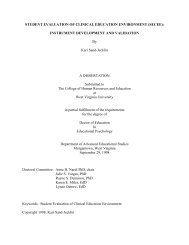The Use of Native Plants for Revegetation along West Virginia ...
The Use of Native Plants for Revegetation along West Virginia ...
The Use of Native Plants for Revegetation along West Virginia ...
You also want an ePaper? Increase the reach of your titles
YUMPU automatically turns print PDFs into web optimized ePapers that Google loves.
near Baker, Hardy County. This is in the Eastern Ridge and Valley province, which is a<br />
lowland, above which rises longitudinal ranges. <strong>The</strong> area has a trellis-type drainage pattern and<br />
is dominated by farmland and oak-hickory-pine <strong>for</strong>ests (Strausbaugh and Core, 1977).<br />
<strong>The</strong> second site is located on I-79 at the <strong>West</strong> <strong>Virginia</strong> Welcome Center, near Hazelton,<br />
Preston County, in the Allegheny Mountain and Upland province <strong>of</strong> the state. This area is<br />
composed <strong>of</strong> northeast-southwest oriented mountain ranges, with deep intervening valleys.<br />
Drainage is dendritic in nature (Skousen and Fortney, 2003) and the vegetation can be described<br />
as belonging to the Northern Evergreen and Hardwood <strong>for</strong>est types (Strausbaugh and Core,<br />
1977).<br />
<strong>The</strong> third site is located near the intersection <strong>of</strong> I-77 and U.S. Route 50 in Parkersburg, Wood<br />
County, in the <strong>West</strong>ern Hill province <strong>of</strong> the state. It is characterized as a mature plateau <strong>of</strong><br />
strong to moderate relief. <strong>The</strong> drainage pattern is dendritic and the vegetation is classified as the<br />
Central Hardwood <strong>for</strong>est type (Strausbaugh and Core, 1977).<br />
<strong>The</strong> study consists <strong>of</strong> testing five seed mixtures with two fertilizer treatments in a completely<br />
randomized design with four replications per treatment combination (40 plots per site). Plots<br />
measure 2m by 2m, with a 1-m buffer area between plots and were established in four rows <strong>of</strong><br />
ten plots each, covering an 11m by 29m area. Seeded species and seeding rates within each seed<br />
mixture are shown in Table 2. <strong>Native</strong> species were chosen according to several criteria. <strong>The</strong>y<br />
should be documented to occur naturally throughout the state (i.e. not specific to one location<br />
within the state), have the potential <strong>for</strong> sediment and erosion control, have esthetic or wildlife<br />
value, be widely available <strong>for</strong> purchasing from suppliers, and be cost-effective <strong>for</strong> large scale<br />
plantings.<br />
Plots were established in April 2002. <strong>The</strong> soil was lightly tilled prior to seeding and plot<br />
boundaries were established with wooden stakes and twine. Fertilizer and seed was spread by<br />
hand on designated plots. <strong>The</strong> fertilizer used was a 10-20-20 N-P-K fertilizer at a rate <strong>of</strong> 150<br />
kg/ha. After fertilizing and seeding, straw mulch was spread over the plots at an approximate<br />
rate <strong>of</strong> 1500 kg/ha to obtain about 80% coverage, then covered with a light plastic erosion<br />
control blanket to hold the straw in place. Plots were surveyed in June and October 2002 and<br />
2003, and in June and September 2004 <strong>for</strong> total plant cover and dominant species. This was<br />
done by visually estimating projected cover contributed by the vegetation in four, randomly<br />
selected, 0.25m by 0.25m sub-plots. Cover was recorded as a class (Table 3) and the midpoint <strong>of</strong><br />
14












